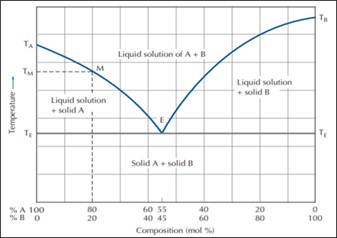Identification of an Unknown Organic Compound by Determination of its Melting Point
DOI:
https://doi.org/10.26438/ijsrcs.v12i1.184Keywords:
melting point range, eutectic, two-phase diagram, mixed melting point, identification, purityAbstract
The melting point is very useful information for identifying an unidentified organic substance. It is also helpful to define the purity of the substance. Pure substances have a melting point range of 1-2oC, while the impurities lower the melting point and increase the melting range. In a mixture of two substances, the melting point can be calculated by creating a two-phase melting diagram. The lowest temperature at which the melting point of a mixture can be reduced is called the eutectic point. The melting point is measured on a special heated apparatus using a glass capillary tube. The sample is placed in the tube, which is heated in the device. In the following study, the melting point of an unknown organic compound was measured by the fast and the slow rate heating method. The melting point of the sample showed that the chemical compound to be identified was either acetanilide or 4-nitrophenol. Equal amounts of the unknown substance and acetanilide were mixed, and the melting point was estimated for the mixture. If the mixture has a lower melting point compared to that of the unknown compound, then the two compounds are different, and one acts as an impurity to the other. The mixture had a similar melting point to that of the unknown compound, and therefore the unknown compound was identified as acetanilide C6H5NH(COCH3).
References
D.J. Hart, L.E. Craine, H. Hart, T.K. Vinod, “Laboratory Manual, Organic Chemistry, A Short Course”, 13th Edition, Brooks/Cole Publications, USA, pp.1-4, 2012.
V.K. Ahluwalia, P. Bhagat, R. Aggarwal, “Laboratory Techniques In Organic Chemistry,” 1st Edition, I.K. International Pvt. Ltd. Publications, India, pp.168, 2005.
V.K. Ahluwalia, S. Dhingra, “Comprehensive Practical Organic Chemistry, Qualitative Analysis,” 3rd Edition, Orient Longman Publications, India, pp.12, 2004.
R.K. Bansal, “A Textbook of Organic Chemistry,” 6th Edition, New Age International Pvt. Ltd. Publisher, India, pp.156, 2016.
J.R. Mohrig, C.N. Hammond, P.F. Schatz, “Techniques in Organic Chemistry,” 3rd Edition, W.H. Freeman and Company Publisher, USA, pp.175-182, 2010.
C.S.K. Reddy, K.K.A. Khan, C. Nagaraja, “A Review on the Determination of Melting Point Measurement System”, Int. Journal Of Advanced Research in Electrical, Electronics and Instrumentation Engineering, Vol.9, Issue.1, pp.39-48, 2020.
S.G. Levine, “Identification of Unknowns by Melting Point and Thin-Layer Chromatography in Combination,” Journal of Chemical Education, Vol.67, Issue.11, pp.972, 1990.
W. Mi, H. Chen, D.(A.) Zhu, T. Zhang, F. Qian, “Melting point prediction of organic molecules by deciphering the chemical structure into a natural language”, Chemical Communications, Vol.57, Issue.21, pp.2633-2636, 2021.
E. Allen, “The Melting Point of Impure Organic Compounds”, Journal of Chemical Education, Vol.19, No.6, pp.278-281, 1942.
B.A.D. Neto, P.S. Beck, J.E.P. Sorto, M.N. Eberlin, “In Melting Points We Trust: A Review on the Misguiding Characterization of Multicomponent Reactions Adducts and Intermediates”, Molecules, Vol.27, No.21, pp.7552, 2022.
K.N. Carter, K.N. Carter Jr., “Meaningful Melting Points”, Journal of Chemical Education, Vol.72, Issue.7, pp.647-648, 1995.
R. Abramowitz, S.H. Yalkowsky, “Melting Point, Boiling Point, and Symmetry”, Pharmaceutical Research, Vol.7, No.9, pp.942-947, 1990.
J.C.O’C. Young, “True Melting Point Determination”, Chemical Educator, Vol.18, pp.203-208, 2013.
N. Walker, K.M. Tam, B. Novak, M. Jarrell, “Identifying Melting Points of Metals from Classical Molecular Dynamics with Unsupervised Machine Learning Methods”, Physical Review E, Vol.98, No.5, 2018.
A. Ault, Techniques, and Experiments for Organic Chemistry, 6th Edition, University Science Books Publications, USA, pp.150-153, 1998.
P.R.S. Murray, Principles of Organic Chemistry, 2nd Edition, Heinemann Educational Books Ltd Publications, Hong Kong, pp.54, 1977.

Downloads
Published
How to Cite
Issue
Section
License

This work is licensed under a Creative Commons Attribution 4.0 International License.
Authors contributing to this journal agree to publish their articles under the Creative Commons Attribution 4.0 International License, allowing third parties to share their work (copy, distribute, transmit) and to adapt it, under the condition that the authors are given credit and that in the event of reuse or distribution, the terms of this license are made clear.





